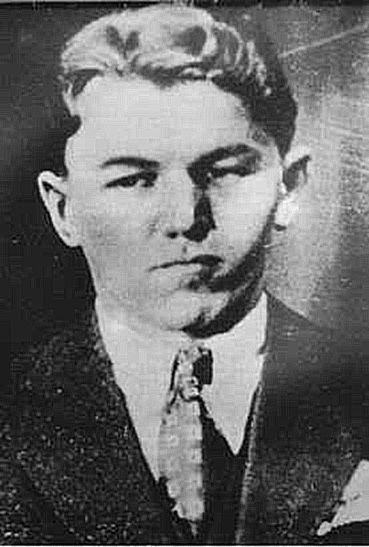By Larry Clinton, Sausalito Historical Society
COURTESY PHOTO
Baby Face Nelson was more dangerous than he looked.
Only a few people in Sausalito knew that the short, boyish bartender at the Walhalla back in 1934 was actually a hardened bank robber and gunman who became infamous as Baby Face Nelson.
After escaping during a transfer from Joliet penitentiary in Illinois in February 1932, Nelson (real name: Lester Gillis) fled west to Reno, where he was harbored by a local crime boss and gambler. From there, he moved to Sausalito, using the alias "Jimmy Johnson," according to the book Public Enemies by Bryan Burrough.
During his Bay area criminal ventures, Nelson met Sausalitan John Paul Chase who became a close associate. As Jack Tracy recounts in his book Moments in Time, “Chase had established a reputation for toughness and reliability as a bootlegger. Chase befriended the quiet, unassuming youth. Lester Gillis, barely five feet, four inches tall, looking even younger than his twenty-three years. Chase found a room for Gillis near his home on Turney Street, in the old Sylva mansion, now converted to a boarding house. Gillis, his nineteen-year-old wife Helen, and their three-year-old son moved into the quiet neighborhood. John Chase learned that Gillis, far different than his mild demeanor indicated, was an escaped convict from Illinois. He was a bank robber, known in Chicago as George Nelson, one of several aliases he used. He was also known there by his childhood nickname, Baby Face.”
“Gillis apparently fooled his Sausalito neighbors and his employer at the Walhalla, where he worked as a part-time bartender. Even his neighbor on Turney Street, constable Manuel Menotti, didn’t suspect that the quiet young man was the dangerous Baby Face Nelson.”
According to Tracy, Gillis taught Chase how to handle a Thompson submachine gun out on the deserted beach at Point Reyes. Tracy’s account continues:
“Gillis grew restless in Sausalito and through San Francisco gangster Joe Parente was introduced to John Dillinger’s gang. After a series of bank robberies and the murder of a federal agent in Wisconsin, Gillis gained nationwide notoriety as ‘Baby Face Nelson,’ feared even by Dillinger himself.” Chicago became too hot for Gillis, so he returned to Sausalito in 1934 with his wife Helen and again met John Chase.
After several weeks had passed, Chase and Gillis headed for Chicago. Accompanying them were several gang members, Helen Gillis, and her young son.
But life on the road was not as glamorous as the media depicted it. The "romantic" era of bank robbers was rapidly coming to an end. On July 22, 1934, Dillinger was ambushed and killed by FBI agents outside the Biograph Theater in Lincoln Park, Chicago. The next day the FBI announced that Pretty Boy Floyd was now Public Enemy No. 1. On October 22, 1934, Floyd was killed in a shootout with FBI agents including Melvin Purvis, famous for manhunts that captured several bank robbers and killed both Dillinger and Floyd. Subsequently, J. Edgar Hoover announced that Nelson was now Public Enemy No. 1 according to the book Baby Face Nelson.
In November Nelson, along with his wife Helen Gillis and John Chase, were on the lam in a stolen V8 Ford headed towards Chicago when Nelson caught sight of a sedan driven in the opposite direction by FBI agents. After a furious but brief gun battle, two agents lay dead, and the fatally wounded Baby Face Nelson was sped away by Chase and Helen Gillis.
Author Bryan Burrough states that Nelson told his wife "I'm done for” and then died in bed with Helen at his side. Helen and Chase dumped his bullet-riddled body in a ditch near a cemetery and went their separate ways.
Nelson's widow wandered the streets of Chicago as a fugitive for several days, described by the Chicago Herald Examiner as the first U.S. female "public enemy.” After surrendering on Thanksgiving Day, Helen served a year in prison for harboring her husband.
John Paul Chase was captured near Mt. Shasta in December 1934, and later sentenced to life imprisonment for murder in the Chicago shootout. Constable Manuel Menotti flew to Shasta City to assist in the identification and capture of Chase when it was learned he was hiding there.
According to the San Francisco Chronicle, Menotti was thanked by no less than J. Edgar Hoover for his help in the arrest of Chase. After Chase was convicted in 1935 the paper reported:
“John Paul Chase, Sausalito boy who ‘made good’ in gangland and shoulder-to-shoulder with Baby Face Nelson, is to spend the rest of his life within rifle range of his boyhood home. But the prospect isn't pleasing to the 33-year-old hoodlum, who was sentenced to life imprisonment after being convicted under one of the new federal gangster-laws. ‘I think I'd rather dangle,’ he told the Associated Press. Chase's sentence will be carried out at the new escape-proof prison Alcatraz, after he has been taken first to Leavenworth for ‘seasoning.’

